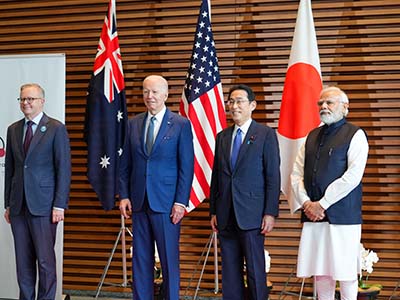The Quad and Regional Security
U.S. Perspectives on the Future of Indo-Pacific Cooperation
This commentary is part of the roundtable “Quad Cooperation in the Indo-Pacific: Regional Security Challenges and Prospects for Greater Coordination.”
The evolution of the Quad over the past fifteen years is a reflection of the rapidly shifting security environment in the Indo-Pacific. From its emergence as a loose framework in 2007, to its resuscitation as a senior-level dialogue in 2017, to its elevation to a leader-level summit with two virtual and two in-person meetings in a little over one year, the Quad has transformed in ways few would have predicted a decade ago, with significant promise to continue to evolve over the next decade.
The United States sees the Quad as a way to address a range of affirmative issues within a framework of shared values and interests. Through the grouping, the United States is able to leverage the strengths of the three other partner nations (Australia, India, and Japan), including their relationships and credibility in their own subregions and their capacity in critical areas, to establish and implement initiatives that meet regional needs. This has resulted in notable progress on confronting and addressing a range of nontraditional security challenges, ranging from a program to source and distribute vaccines to a maritime surveillance program aimed at curtailing illegal fishing.
As part of this affirmative agenda, the Quad collectively has sought to reassure the region that it is not and will not become a formal military alliance, but instead remains focused on promoting a positive vision for regional order. However, concerns about China’s growing influence and military assertiveness continue to play a key role in the initiative’s efforts. The joint statement following a leader-level summit in May 2022 reiterates the Quad’s commitment “to uphold the international rules-based order where countries are free from all forms of military, economic and political coercion”—a clear reference to China.[1] Underpinning this sentiment is the fact that all four countries share similar perceptions of the Indo-Pacific security environment, and perhaps increasingly so, although they often have differing views on exactly how to address the challenges China poses.
For the United States, the Quad serves alongside complementary bilateral and minilateral configurations involving the four nations, such as the U.S.-Australia-Japan trilateral, to support the current administration’s focus on “integrated deterrence.” Each of these groupings has the potential to leverage the strengths of various U.S. alliance and partner relationships to achieve deterrence across domains and regions.
From the U.S. perspective, maritime issues, North Korea, and tensions in the Taiwan Strait are among the most pressing security threats to the region. The following sections examine the Quad’s position on and potential role in responding to these issues, before concluding with the implications for the role specific partners might play in strengthening the Quad’s objectives.
Maritime Security
Despite the Quad having eschewed security as an organizing principle, maritime security has topped its list of priorities since 2017. The four countries have provided assistance in Southeast Asia on maritime law enforcement, implemented a new maritime domain awareness program, cooperated on strengthening humanitarian assistance and disaster relief operations, emphasized the importance of freedom of navigation, and condemned China’s assertive behavior in the maritime domain, particularly the South China Sea. Taken together, the substantive cooperation among the Quad partners on maritime security suggests that greater collaboration is likely going forward to promote a free and open Indo-Pacific.
For the United States, collectively promoting the free and open Indo-Pacific concept, particularly through a greater emphasis on freedom of navigation and international law, remains a high priority to counter China’s sweeping maritime claims and pressure tactics to change the status quo. Alignment within the Quad and collective action on this issue signal to China and the broader region that stability in the maritime domain is a shared regional concern, not a singular U.S. priority.
Additional Quad strengths in maritime security are exemplified by the Malabar exercises. Held annually, the naval exercises have included all four Quad countries since 2020, when Australia rejoined for the first time in thirteen years. Malabar provides a mechanism to increase interoperability and coordination between the four navies, including on antisubmarine warfare. The Chinese media has called the exercises “a pillar of the Asian version of NATO,” which can be read as a decent indicator that China perceives them as a substantial action that challenges its ability to operate its military unchecked in the maritime domain.[2]
North Korea
The second key security threat on which the Quad is broadly aligned is the challenge posed by North Korea and its provocations in the region. In May 2022, North Korea launched three ballistic missiles immediately after the second Quad leaders’ summit in Tokyo. In a joint statement issued soon after, the Quad countries stated the following: “We reaffirm our commitment to the complete denuclearization of the Korean Peninsula…and also reconfirm the necessity of immediate resolution of the issue of Japanese abductees. We also condemn North Korea’s destabilizing ballistic missile development and launches, including multiple ICBM tests.”[3]
While the threats posed by North Korea have tended to take a back seat to the challenges posed by China, the continued missile tests and provocations from North Korea serve as a reminder to the Quad countries that China is not the only actor with the potential to destabilize the region.
Cross-Strait Tensions
The final security challenge that will demand Quad attention is China’s increasingly assertive behavior toward Taiwan. Cross-strait tensions have grown since the last leaders’ summit in May 2022. In August, China launched unprecedented military exercises that amounted to a temporary blockade in response to U.S. Speaker of the House Nancy Pelosi’s visit to the island. China conducted an additional series of exercises in response to President Tsai Ing-wen’s meeting with Speaker Kevin McCarthy during a transit through the United States in April 2023.
To communicate displeasure, apply pressure on Taipei, and work to normalize high levels of Chinese military activity, the People’s Liberation Army continues to send fighter jets into Taiwan’s airspace with increasing numbers and frequency. Meanwhile, the Chinese government also pressures Taiwan economically and diplomatically, as well as through disinformation. Compounding the situation, Russia’s invasion of Ukraine prompted comparisons to a potential future Chinese invasion of Taiwan and has set off a flurry of debates about Taiwan’s defense, particularly in Taipei, Washington, and Tokyo, but also in other capitals.
The Quad countries’ views on Taiwan are far from perfectly aligned. In fact, the May joint statement did not include a single mention of Taiwan, a stark contrast with the unified statement on North Korea. This caution again speaks to the desire of the Quad to not be perceived in the region as an alliance countering China. Instead, it chooses to focus on an affirmative vision that resonates well in places like Southeast Asia.
Nonetheless, the Quad remains a useful platform for strategic dialogue, including discussions on the catastrophic impacts of a potential Taiwan contingency on the region. The United States sees conversations about the strategic and economic implications of a conflict over Taiwan for individual countries as an important factor in gaining the support of those in the region to dissuade or deter China from using military force. The Quad can also continue to build trust and relations between individual members and Taiwan, as well as encourage other regional countries to deepen economic ties with Taiwan.
The individual policy communities in Washington, Tokyo, and Canberra have each experienced significant shifts in their approaches toward the Taiwan issue in the past several years, leaving New Delhi as the conspicuous outlier. The United States, which has seen a flurry of recent bipartisan support for Taiwan across both the executive and legislative branches, certainly hopes to persuade India that a unified Quad stance on Taiwan would send a strong message to Beijing and advance the objectives of integrated deterrence.
Strengthening Quad Coordination on Security
The prospects for the Quad to increase its formal emphasis on security issues remain fairly low, given the ongoing progress on nonsecurity issues like public health, infrastructure, and climate change and the careful messaging to the region. However, strengthened coordination between the various legs of the quadrilateral, including bilaterally and trilaterally, on the three security issues discussed above certainly aligns with U.S. interests.
To that end, this is one of the key areas in which Japan can continue to offer leadership, both in the Quad and in its bilateral relationships throughout the region. In a speech in London in May 2022, Prime Minister Fumio Kishida said that “peace and stability in the Taiwan Strait is critical not only for Japan’s security but also for the stability of international society,”[4] a point he repeated in a parliamentary session in April 2023.
Japan’s growing support for Taiwan, both in high-level speeches and diplomatically in international forums, can reinforce this very message to the rest of the Quad, particularly India. Japan has been a crucial leader in bringing the Quad back to life since 2017. As Japan and India’s diplomatic and defense relations grow closer, Tokyo can use its respected voice to encourage New Delhi to strengthen engagement with Taiwan.
Additionally, the United States’ own bilateral relationships with each of the other Quad partners continue to deepen and become more integrated, particularly in the security domain. This in turn creates additional opportunities to expand integration on security issues to trilateral or minilateral configurations, including within the Quad. Washington has welcomed Japan’s new national security and defense strategies, which thrust the country into a more proactive security role in the region and re-emphasize the critical role of the U.S.-Japan alliance for shared strategic interests. U.S.-Australia strategic relations are also deepening as the countries work to implement their historic AUKUS agreement with the United Kingdom. If fully realized, AUKUS could see unprecedented levels of intelligence sharing, defense industry cooperation, and military coordination. While U.S.-India defense ties are less formalized, the two countries have continued consultations to strengthen their defense partnership, including through defense industry and strategic technology cooperation. The trajectories of each of these bilateral relationships and the shared strategic interests position them well to contribute to overall strengthened coordination within the framework of the Quad.
Finally, as the Quad demonstrates that growing cooperation among its members is more than a short-term trend, with leader engagements and successfully implemented programs providing public goods, it has drawn the interest of several other countries in the region hoping to work with and align with the Quad. For example, Singapore and the Republic of Korea (ROK) have joined the Quad in working groups on specific domains.
South Korea in particular is at a key juncture in becoming a critical partner for the Quad. The combination of stabilizing ROK-Japan diplomatic relations and the Yoon administration’s expressed desire for South Korea to play a more active role in regional security presents an opportunity for the Quad to bring the country into additional working groups and meetings related to shared interests. Doing so could help the align the ROK with the Quad’s vision for regional security.
Alison Szalwinski is Vice President of Research at the National Bureau of Asian Research (NBR). In this role, she provides executive leadership to NBR’s policy research agenda and oversees research teams in Seattle and Washington, D.C.
Endnotes
[1] “Quad Joint Leaders’ Statement,” May 24, 2022, https://www.whitehouse.gov/briefing-room/statements-releases/2022/05/24/quad-joint-leaders-statement.
[2] Zhang Yi, “Malabar Naval Drills to Increase Geopolitical Risks in the Region,” Global Times, November 3, 2020. https://www.globaltimes.cn/content/1205586.shtml.
[3] “Quad Joint Leaders’ Statement.”
[4] “Ukraine Plight Could Be Replicated in East Asia, Japan’s Kishida Warns,” Reuters, May 6, 2022, https://www.reuters.com/world/asia-pacific/peace-stability-taiwan-strait-is-critical-japanese-pm-2022-05-05/.



